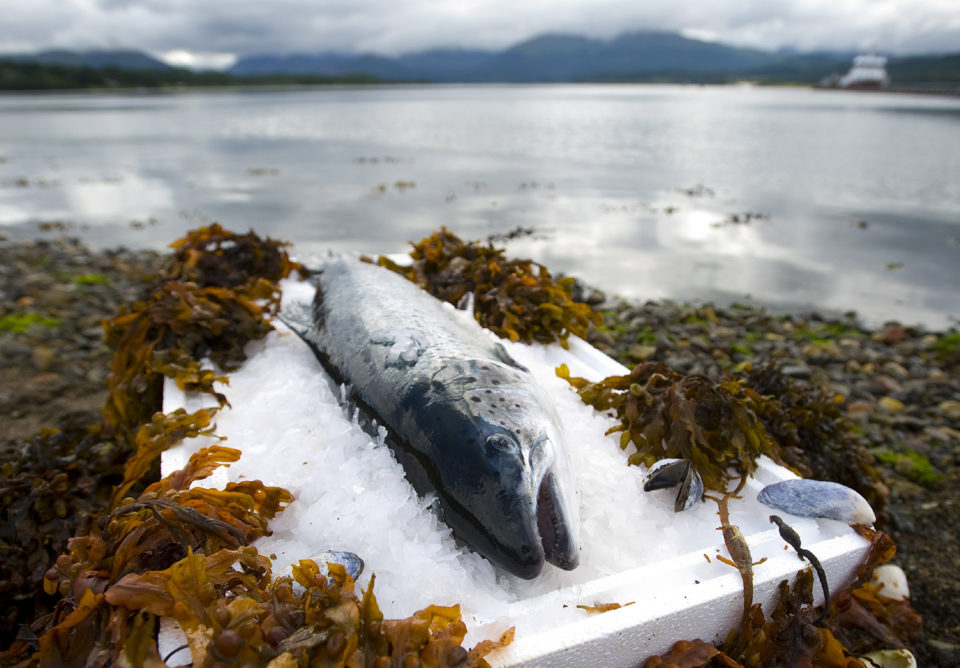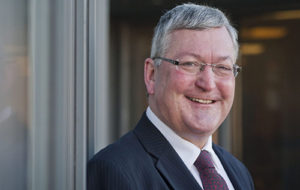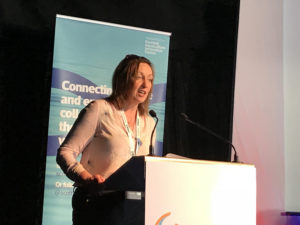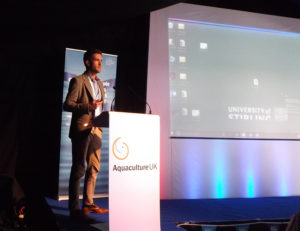Britain getting on board with fish farming

Even factoring in salmon farming, the United Kingdom’s contribution to the global aquaculture economy has to-date been a relatively modest one. There is, however, a growing recognition that this is a space with considerable potential, particularly post-Brexit. With the right framework in place, many say, it could achieve much more and reap big rewards along the way.
U.K. Fisheries Minister George Eustice is among those that frequently cite the opportunities that exist within fish and shellfish culture, specifically through enabling a competitive aquaculture industry. Indeed, he told the Shellfish Association of Great Britain (SAGB) Annual Conference in London last month that aquaculture was a key part of the government’s future plans.
“My view is that if dealt with correctly, it will get greater certainty with regard to incoming marine plans regarding such things as licensing. I know we are not there yet, but that is what the marine plans should be doing – we are hoping to give you greater clarity, certainty and to speed up the process,” he said.
More recently, at the Aquaculture UK exhibition and conference in Aviemore, Scotland (23-24 May), Fergus Ewing, the Scottish government’s cabinet secretary for the rural economy and connectivity, highlighted the growing economic importance that the sector has for Scotland, where much of U.K. aquaculture takes place. He also pointed out that it is increasingly investing in itself to overcome its challenges.

“Aquaculture is a valuable sector, with farmed salmon the United Kingdom’s No.1 food export, supporting 12,000 jobs and making a major contribution to rural, island and coastal communities,” he said.
Together with Marine Harvest (Scotland) Ltd. Managing Director Ben Hadfield, Ewing launched the “Fish Health Framework” at the two-day event. This 10-year plan is aimed at growing the production and export of farmed seafood while also improving fish health and the marine environment. Key activity areas outlined within the plan include managing sea lice, ensuring improved information flows and transparency, and tackling issues around climate change.
“The framework sets out a clear and transparent program of activity, which will ensure people at home and around the world can continue to enjoy and benefit from Scotland’s nutritious and sustainable farmed fish,” he said.
While the strategy has long-term ambitions, Ewing believes short-term action is key. He therefore expects all of the plan’s groups to be up and running within three months and making rapid progress this year.
Underlining the importance of Scotland’s salmonid sector, Hadfield, who is also co-chair of the Framework Working Group, said the new initiative sets out collaborative activities to ensure industry growth is achieved in the most sustainable way.
“Ensuring good health status of our salmon and trout stocks will maximize the economic contribution, while minimizing the environmental footprint of our farming operations,” he said.
Accelerating innovation
There is significant scope to improve Scotland’s aquaculture productivity and align it to global demand, acknowledged Elaine Jamieson, head of food and drink at Highlands and Islands Enterprise (HIE).
With most Scottish aquaculture taking place in remote and rural areas, the industry is of particular importance to the economic and social prosperity of the highlands and islands, “where it’s sometimes touted as the new oil and gas industry,” she said. Recent HIE and Marine Scotland research also forecasts that the industry has a more certain future in terms of customer demand and scope to grow compared with other sectors in the economy. It additionally learned that aquaculture’s overall impact on the economy was much greater than previously thought.
These findings complement the industry-led strategic plan “Aquaculture Growth to 2030,” which sets out the objectives, aspirations and means to double the current production value to £3.6 billion ($4.8 billion) within the next 12 years, and in doing so employ some 18,000 people. To realize these ambitions, six strategic priorities have been identified: industry leadership and ambition; enabling and proportionate regulation; accelerating innovation; skills development; finance; and infrastructure.

Jamieson highlighted that the accelerating innovation priority recognizes that to enable significant growth both investment and innovation in processes, equipment, technology etc. will be “absolutely critical” to overcoming existing and new emerging challenges.
“Strategies suggest that innovation must focus on addressing biological health and environmental challenges such as sea lice and stimulating and supporting supply chain excellence and global competitiveness, particularly among our indigenous small- and medium-sized enterprises (SMEs),” she said. “This strategy believes that all of these will contribute to industry growth in volume – yes, but critically in value.”
Despite the positive landscape, HIE has found that innovations coming out of SMEs are considerably fewer in number than the overall industry average.
“This is most likely because a lot of ideas don’t make it through to commercial realization,” said Jamieson, adding that a lack of capital within those enterprises and access to finance has so far been a major limiting factor. “So it makes sense to us that we provide innovation support to SMEs, including a financial intervention which, to put it bluntly, is a necessary enabler. We believe this targeted support for an SME aquaculture supply chain will help businesses develop capability and scale.”
Launched last year, the Accelerating Aquaculture Innovation (AAI) program is a £1 million ($1.3 million) innovation fund to help address the low levels of SMEs R&D that’s being commercialized in the supply chain. This initial 30-month pilot scheme is led by HIE and delivered in partnership with Scottish Aquaculture Innovation Centre (SAIC).
Where applications are successful, the AAI program could provide up to half the project cost, but Jamieson stressed that the projects must demonstrate opportunity and demand.
“We need to be able to see that you can commercially exploit your idea,” he said. “Your idea must also have the potential to grow the business and you must imbed the idea in the business to allow that growth to happen.”
With other public-sector support available for the early stages of innovation, this program also focuses explicitly on accelerating the latter stages of the innovation journey through to launch.
“That’s the commercialization of new products and services, both upstream and downstream, across the whole breadth of this supply chain.”
The AAI program has already had 25 enquiries, of which nine have been taken forward to expressions of interest (EOIs) and three are at the stage of full application of awards.
Meanwhile, looking ahead to 2030 and what the Scottish finfish and shellfish farming landscape might look like, Jamieson told the conference that she reckons there’s a broad range of factors that will play out as well as a raft of technologies that, depending on their adoption, will shape aquaculture.
The industry currently faces a number of biological and environmental challenges and that will drive innovation, she added.
“There is a broad church of stakeholders,” she said. “For me, it’s not so much about what we should strive for [aquaculture] to look like by 2030, it’s about making sure that the key actors in that very broad church work together to ensure we have a very sustainable industry that is supported by a supply chain that’s competitive and profitable.”
Aquaculture jobs are high-quality opportunities, she added.
“There are a number of things that [aquaculture] should look like, but it’s within our own gift to shape that and take responsibility,” she said.
Musseling in: New production level set
Scottish salmon farming had a stellar 2017, with growth up 35 percent and exports reaching a record value of £600 million ($805.1 million). The shellfish sector, meanwhile, was dominated by farmed blue mussels (Mytilus edulis) with the 8,232 metric tons (MT) that were produced for the table market last year representing the highest level of mussel production ever recorded in Scotland. A further 4,437 MT were produced for on-growing.
These bivalves achieved a total first-sales value of £10.1 million ($13.5 million), which accounted for the lion’s share of the total £12.4 million ($16.6 million) first-sales value achieved by Scottish shellfish producers last year.
Dr. Tom Ashton, operations director and co-founder of Xelect Ltd., a genetic service company for the aquaculture industry, confirmed that Scotland’s mussel farming sector has grown steadily over the past 10 years and that there’s “great potential” to continue ramping up its output.

“It’s highly sustainable, the environmental impact of mussel farming is negligible, and the coastline could support a lot more mussel growing,” he said. “However, this growth is limited by a major problem – the availability of mussel spat. The mussel farming industry is still based on collecting wild juveniles, which involves dealing with biological fluctuations in the environment.”
This “critical” dependability on wild spat has led Xelect to conduct research into the potential of modernized mussel hatcheries, which incorporate molecular tools, to optimize the controlled breeding of these bivalves. The overriding aim is to provide more robust, more disease-resistant, faster-growing and higher-quality end products.
The project is based in Shetland, which is responsible for around three-quarters of Scotland’s mussel production.
“Hatcheries would allow a consistent and sustainable supply of spat,” Ashton said. “Another benefit of a hatchery is it allows the continuous improvements of traits through selective breeding.”
But he also acknowledged the danger brought by continually focusing on one genotype: If you are selecting animals based on a preferred trait and that you are also likely to be heightening genetic similarity.
“That is highly dangerous in any breeding program,” said.
Therefore, genetic diversity also needs to be monitored, which is principally done with molecular genetic tools – markers that can be used to identify species and traits.
“So when you are crossing animals of any breeding design, you are doing so in full sight of the genetics, avoiding inbreeding and keeping a healthy population,” he said.
One of the key aims of this project was to develop such genetic tools. First though, there is the issue of species hybridization. Mussels don’t exist as a single species. Scottish waters have three similar Mytilus species that hybridize very easily, but the variety that the sector wants is the most commercially valuable target species of Mytilus edulis.
“This is the first piece of research – to get a good hatchery population. And then we need to do some genomic sequencing and development of marker panels. [Xelect] has done this for a variety of species, but it’s not so easy with bivalves and this has given us some interesting technical challenges,” he said.
Xelect was aware from other bivalve genome research that mussel populations can have a very high density of genetic variation. To overcome this, the company is deploying a haplotyping technique. In layman terms, a haplotype is an individual’s set of genetic markers. If two individuals have matching markers, they are said to share the same haplotype and to be related. Just how related they are depends on the number of markers that have been tested, so the more markers that are tested and compared, the more accurate the analysis.
“We now have haplotype panels for Atlantic salmon ready for commercial implementation and we are [getting] close to having them for a number of other commercial aquaculture species,” he said. “With a little investment, we could get haplotypes ready for mussels. This would really facilitate rapid, cost-effective, but above all highly accurate genotyping of these potentially very tricky genomes.”
Ashton said that through genetic control, the project’s hatchery in Shetland would be able to facilitate the implementation of any trait that the producer wants to push.
“That is the future, we hope. I am pretty pleased with the way that the project has gone so far. We are making good progress toward this but it’s not done yet, we’ve got more work to do,” he said. “I think if there was pressure on this now, with funding and investment, we could get the genetic tools ready in a matter of months.”
There is also the scope to expand into other bivalves, he confirmed.
“We could be breeding sustainable, trait-improved scallops, oysters,” he said. “The native oyster would be an excellent example, where trait-improved growth rate, for example, would make them more disease resistant. There’s a huge potential.”
Ph.D. funding for the future
If the United Kingdom is to realize its aquaculture ambitions, it will need to ensure closer ties are established between researchers and the commercial industry, Aquaculture UK attendees were told.
To help expand the pool of young, talented, industry-savvy aquaculture scientists in Scotland, SAIC has announced it will fund four Ph.D. projects to the tune of £180,000 ($241,566), with matched funding from universities and commercial contributions taking the research pot up to £500,000 ($671,016).
This is the first time that SAIC has directly funded Ph.D. positions, and each will tackle an area deemed a priority for the country’s aquaculture sector. Each academic also needs to have an industry partner.
“We wanted to see a greater critical mass of upcoming scientists coming out of Scottish universities and being exposed to the commercial industry from the very beginning of their PhDs,” said Heather Jones, CEO of SAIC.
Three of the recipients announced at the event will focus on fish health issues and one will address mussel farmers’ needs:
- Dynamic spatial modeling and forecasting of sea lice abundances: Predictive tools to understand where sea lice present the greatest geographical pressures. (This research will be in partnership with the Scottish Association for Marine Science (SAMS) and Marine Harvest.)
- Photoperiod and immune function: How critical lifecycle events in salmon impact on disease response and post-smolt performance to better understand how photoperiod/artificial light regimes affect the immune system through the critical transfer from freshwater to seawater. (In partnership with the University of Aberdeen and Scottish Sea Farms.)
- Environmental DNA for low-cost monitoring of disease in salmonid aquaculture: More efficient and cost-effective ways to monitor the presence of a range of pathogenic/dangerous organisms in the local environment of salmon aquaculture, such as the two species of sea lice found in Scottish waters and the causative agent of amoebic gill disease (AGD). (In partnership with the University of Glasgow, Marine Harvest, Scottish Sea Farms and Bioclavis.)
- Spat mortality in farmed blue mussels: Understanding the causes of mortality in spat fall to enhance the productivity of Scottish mussel farms. (In partnership with the University of Stirling’s Institute of Aquaculture and Fassfern Mussels Ltd., with additional funding from The Fishmongers Company.)
“I am delighted that the four Ph.D. students will embark on industry-relevant research to help improve production capacity and I wish them every success,” said Jones.
If the initial scheme is deemed a success, SAIC will look to scale it up in the future, she added.
SAIC connects industry with academia to deliver innovative solutions to challenges that the industry faces. In the four years that it has been going, it has funded 25 projects that are now worth £34 million ($45.6 million).
Industry gongs
Aquaculture UK also hosted the inaugural Scottish Marine Aquaculture Awards, with 12 prizes given across a number of categories.
Among the top honors, Gael Force Group managing director Stewart Graham received an outstanding contribution to the industry award. Graham played a key role in launching the Aquaculture Growth to 2030 strategy.
The People’s Choice Award went to Stuart Cannon of Kames Fish Farming, who has worked in the sector since 1972.
Marine Harvest (Scotland) scooped the Aquaculture Company of the Year title, as well as the Community Initiative Award for establishing a new farm on the island of Rum, and the Innovation Award for developing a net that helps maintain the gill health of salmon.
Scottish Shellfish Marketing Group’s quick-cook moules frites, developed in partnership with supermarket chain Morrisons, took Aquaculture Seafood Product of the Year, while the awards for the best shellfish and finfish farm managers were won by Robert Lamont of Loch Ryan Oyster Fishery Company, and Sarah Last of Scottish Sea Farms, respectively.
Mull-based Inverlussa Marine was named Aquaculture Supplier of the Year, Akva Group Scotland won the Business Development Award, and the Stewardship & Sustainability Award went to Carly Daniels, of Cornwall’s National Lobster Hatchery.
The Rising Star Award was jointly presented to Lynne Frame, hatchery specialist at Scottish Sea Farms, and Scott MacKay of AKVA Group Scotland.
Follow the Advocate on Twitter @GAA_Advocate
Author
-

Jason Holland
Jason Holland is a London-based writer for the international seafood, aquaculture and fisheries sectors. Jason has accrued more than 25 years experience as a B2B journalist, editor and communications consultant – a career that has taken him all over the world. He believes he found his true professional calling in 2004 when he started documenting the many facets of the international seafood industry, and particularly those enterprises and individuals bringing change to it.
Tagged With
Related Posts

Aquafeeds
Fish oil alternatives are waiting in the wings
The Future of Fish Feed (F3) initiative aims to jumpstart innovation in terms of viable fish-free substitutes to fish oil through the global F3 Fish Oil Challenge.

Aquafeeds
Canada eagerly looks to camelina oil as a fish oil alternative
Grown worldwide, Camelina sativa is a tiny seed used for human consumption that also has big potential for driving the “green” economy.

Innovation & Investment
Aquaculture Exchange: Tom Pickerell
The technical director for the U.K. seafood industry authority, Seafish, talks to the Advocate about the challenges facing aquaculture expansion and why it will be seafood that fills the protein gap that many are expecting in the future.

Innovation & Investment
Norway showcases halibut farm as sustainability star
Recognizing its potential as a sustainable fish producer, Norway highlights land-based halibut farmer Sogn Aqua in the debute of The Explorer digital showroom. The Advocate recently paid a visit to the farm in Ortnevik.

